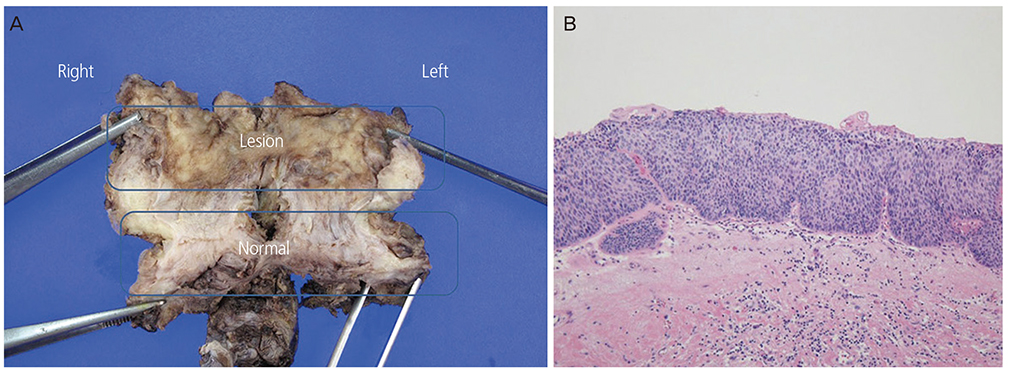Obstet Gynecol Sci.
2016 Jan;59(1):71-74. 10.5468/ogs.2016.59.1.71.
Total vaginectomy for refractory vaginal intraepithelial neoplasia III of the vaginal vault
- Affiliations
-
- 1Department of Obstetrics and Gynecology, Ewha Womans University School of Medicine, Seoul, Korea. medok74@gmail.com
- KMID: 2152649
- DOI: http://doi.org/10.5468/ogs.2016.59.1.71
Abstract
- Vaginal intraepithelial neoplasia III, is a relatively rare disease. Consequently standard treatments for this disease were not established until recently. Although several convenient methods, such as laser ablation, 5-fluorouracil topical injection, and radiation therapy, have been applied for treating these lesions, surgical treatments, including vaginectomy, have not yet been attempted, as they would likely be accompanied by technical difficulties and various complications. Herein, we report a case of refractory vaginal intraepithelial neoplasia III in the vaginal vault that was successfully treated with a total vaginectomy.
Figure
Reference
-
1. Li Z, Barron S, Hong W, Karunamurthy A, Zhao C. Surveillance for recurrent cancers and vaginal epithelial lesions in patients with invasive cervical cancer after hysterectomy: are vaginal cytology and high-risk human papillomavirus testing useful? Am J Clin Pathol. 2013; 140:708–714.2. Frega A, Sopracordevole F, Assorgi C, Lombardi D, DE Sanctis V, Catalano A, et al. Vaginal intraepithelial neoplasia: a therapeutical dilemma. Anticancer Res. 2013; 33:29–38.3. Hatch KD. A3. Vaginal intraepithelial neoplasia (VAIN). Int J Gynecol Obstet. 2006; 94:S40–S43.4. Dodge JA, Eltabbakh GH, Mount SL, Walker RP, Morgan A. Clinical features and risk of recurrence among patients with vaginal intraepithelial neoplasia. Gynecol Oncol. 2001; 83:363–369.5. Sillman FH, Fruchter RG, Chen YS, Camilien L, Sedlis A, McTigue E. Vaginal intraepithelial neoplasia: risk factors for persistence, recurrence, and invasion and its management. Am J Obstet Gynecol. 1997; 176(1 Pt 1):93–99.6. Song JH, Lee JH, Lee JH, Park JS, Hong SH, Jang HS, et al. High-dose-rate brachytherapy for the treatment of vaginal intraepithelial neoplasia. Cancer Res Treat. 2014; 46:74–80.7. Ogino I, Kitamura T, Okajima H, Matsubara S. High-dose-rate intracavitary brachytherapy in the management of cervical and vaginal intraepithelial neoplasia. Int J Radiat Oncol Biol Phys. 1998; 40:881–887.8. Holschneider CH, Berek JS. Valvar cancer. In : Berek JS, Novak E, editors. Berek & Novak's gynecology. 14th ed. Philadelphia (PA): Lippincott Williams & Wilkins;2007. p. 561–602.9. Diakomanolis E, Rodolakis A, Boulgaris Z, Blachos G, Michalas S. Treatment of vaginal intraepithelial neoplasia with laser ablation and upper vaginectomy. Gynecol Obstet Invest. 2002; 54:17–20.10. Hoffman MS, DeCesare SL, Roberts WS, Fiorica JV, Finan MA, Cavanagh D. Upper vaginectomy for in situ and occult, superficially invasive carcinoma of the vagina. Am J Obstet Gynecol. 1992; 166(1 Pt 1):30–33.11. Indermaur MD, Martino MA, Fiorica JV, Roberts WS, Hoffman MS. Upper vaginectomy for the treatment of vaginal intraepithelial neoplasia. Am J Obstet Gynecol. 2005; 193:577–580.
- Full Text Links
- Actions
-
Cited
- CITED
-
- Close
- Share
- Similar articles
-
- Four Cases of Repair of Post Hysterectomy Vaginal Vault Prolapse
- Five cases of abdominal sacral colpopexy for the vaginal vault prolapse after total hysterectomy
- Effectiveness of 5-FU Cream in the Management of Vaginal Intraepithelial Neoplasia
- Three cases of vaginal evisceration after laparoscopic hysterectomy
- Vaginal vault evisceration after total laparoscopic hysterectomy



